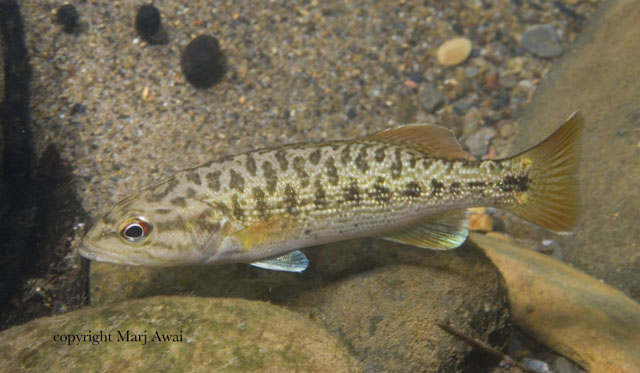| Centrarchidae (Sunfishes) |
| 47 cm TL (male/unsexed); max.weight: 3,710.0 g; max. reported age: 10 years |
|
demersal; freshwater |
| North America: Savannah, Chattahoochee and Mobile Bay basins in North Carolina, South Carolina, Georgia, Tennessee and Alabama in the USA. |
|
Dorsal spines (total): 10-10; Dorsal soft rays (total): 12-14; Anal spines: 3-3; Anal soft rays: 10-11. A member of Micropterus coosae species group but differs from all other members of the group by having red on the distal one-half of second-dorsal, caudal, and anal fins, and entire length of pectoral-fin rays (vs. green, yellow-green, or orange on smaller portions of fins in other species) and midline row of blotches partial to lacking, typically with 6 or fewer anterior vertical blotches with the remainder too diffuse to recognize as blotches or spots (in 76% of individuals; remaining 24% with midline row of blotches extending total body length, having 10-13 blotches). It further differs from M. tallapoosae and M. chattahoochae by a combination of the following characters: smaller scales (2.6 vs. 2.9% SL); higher scale counts, including lateral-line scales (mode 70 vs. 65 or 66; range 68-73 in 83.8% vs. 61-67 in 77.2%), and scale rows around caudal peduncle (mode = 30 vs. 29; range 30-32 in 80.0% vs. 26-29 in 94.1%). It can be further separated from M. warriorensis by the presence of a tooth patch (vs. absent; from M. tallapoosae, M. warriorensis, M. cahabae, M. chattahoochae, and M. cf. coosae (Savannah River) by a narrower postfrontal width 11.0% SL (vs. 11.2% SL or more); and from M. cahabae by the presence of more pronounced white tips on the caudal fin (Ref. 93229). |
| Inhabits rocky runs and pools of creeks and small to medium rivers (Ref. 205); also found in upland streams (Ref. 10294). Oviparous (Ref. 205). |
|
Least Concern (LC); Date assessed: 01 March 2012 Ref. (130435)
|
| harmless |
Source and more info: www.fishbase.org. For personal, classroom, and other internal use only. Not for publication.
